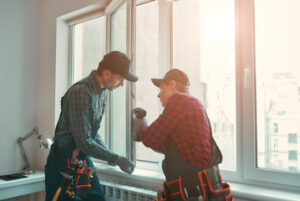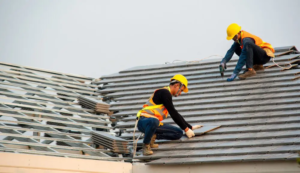If your windows are hard to open or you’ve noticed moisture between the glass panes, it may be time for a replacement. This home improvement project can provide many benefits, including improved energy efficiency.

Replacement Windows Massachusetts also have a higher air infiltration rating, keeping your home warmer in the winter and cooler in the summer. They’re also made to reduce outside noise.
Energy efficient windows help to reduce your home’s energy consumption, which in turn lowers your household energy bills. They also have insulating properties that keep homes cooler in the summer and warmer in the winter, thereby reducing the need for air conditioning and heating systems to work harder.
New replacement windows are designed to fit into existing window openings, so they are easier and faster to install than a typical DIY project. However, a professional installer will still be needed to ensure proper installation and optimal performance.
Many energy-efficient options offer better insulation than traditional windows, as well as advanced coatings that reduce the penetration of harmful UV rays into the home’s interior. This helps to preserve the appearance of floors, furniture, and fabrics and prolongs their lifespan.
In addition to providing a more comfortable indoor environment, energy-efficient replacement windows also help to reduce outside noises such as traffic, construction, and general ambient noise. This can create a more peaceful and relaxing home environment, especially for homeowners with young children or pets that need a quiet place to rest or play.
The best way to determine if your windows are energy efficient is to conduct an energy audit at your home. The results of this assessment will provide you with a clear understanding of how your home uses energy and where it’s being wasted. This information can help you make the best decision regarding the type of replacement window that will benefit your home the most.
Increased Home Value
As a homeowner, you’re probably always on the lookout for ways to add value to your home. One of the most common upgrades you’ll see advertised is that new windows increase your home’s resale value. But does this claim hold up?
The answer is a resounding “yes.” Windows are among the most popular home improvements and consistently rank as a top home improvement project for increasing resale value. According to Remodeling Magazine’s Cost vs. Value Report, you can expect to recoup 60-70% of the cost of replacement windows at the time of sale.
Not only do new windows enhance your home’s aesthetic appeal, they also boost its energy efficiency and natural light intake. This makes your house more attractive to potential buyers and helps you stand out in the competitive Philadelphia real estate market.
Additionally, today’s advanced window technologies offer many features that make your home easier to maintain and more functional. Convenient features like between-the-glass blinds reduce dust and messes, while sashes that tilt in allow you to clean the outside of your windows from inside your home. This eliminates the need for ladders and helps you save time.
Another important benefit is enhanced security. Old windows can leave your house vulnerable to intruders, whereas modern locks and stronger frames help deter crime. As a result, replacement windows can provide peace of mind and a better night’s sleep. This, in turn, can boost your home’s resale price and improve your overall quality of life.
Increased Comfort
If your windows are difficult to open or close due to age, you’re missing out on a number of benefits. New windows can offer easy-to-operate handles and smooth sliding tracks that make opening and closing a breeze. This improved functionality helps you regulate the temperature of your home, which may also lead to energy savings.
A window replacement also reduces outside noise. You’ll be able to focus, relax, and unwind without being interrupted by the sounds of traffic, sirens, lawnmowers, construction, and more. While they won’t silence outside noise completely, they can greatly decrease it, providing a calm and relaxing indoor atmosphere for you and your family to enjoy.
Unlike traditional windows, new replacements feature double or triple panes of glass that are insulated to prevent drafts. This added insulation will help you maintain a comfortable indoor temperature all year round, no matter the season. Additionally, newer windows are designed with multiple layers of argon gas in between the panes to further reduce outside noise and heat transfer.
Another benefit of replacing your windows is that they are essentially maintenance-free. Vinyl frames are resistant to extreme temperatures and staining, which makes them easier to clean than wood frames that require refinishing or painting every few years. This reduced maintenance saves you time and money over the long run.
New windows are a beautiful addition to any home, but they’re especially important for older homes that have been damaged or worn down over the years. They can improve air quality, temperature equilibrium, energy efficiency, security, and more, making them an investment worth the cost for homeowners. Contact Fairview Home Improvement today to learn more about how replacement windows can boost your home’s comfort and beauty!
Increased Security
Windows are more than just an aesthetic feature in your home; they also serve as a critical component of your family’s safety. If your old windows have flimsy locking mechanisms, are poorly secured or don’t lock at all, then they can pose security risks for your home and your family. Thankfully, new replacement windows are equipped with advanced locking mechanisms and reinforced frames, making them a strong deterrent against potential intruders and burglars.
Additionally, replacement windows can be paired with impact-resistant glass that can reduce the risk of injuries and property damage in the event of an intrusion. This can be a huge comfort to homeowners who want to feel confident that their family is safe and secure in their own home.
Finally, many replacement windows are designed to fit into existing window openings, making them a practical option for older homes. This means that the installation process is less invasive and requires fewer repairs to your home’s trim work, drywall and siding.
If you’re looking to replace your windows, the autumn season is an excellent time to do so. This is when the weather is cooler and dry, which makes it easier for professionals to install your new windows. Then, you can enjoy your improved energy efficiency, comfortability and security all year round!
Reduced Noise
In addition to their energy efficiency benefits, Replacement Windows can also help reduce unwanted noise pollution. Whether it’s from traffic or noisy neighbors, it can be difficult to relax at home when outside noises interrupt your peace and quiet. Noise-reducing windows are available in a variety of styles to fit your aesthetic preferences. Many of these window types feature double- or even triple-pane glass that can significantly reduce the amount of outside noise that enters your home.
Some windows also incorporate inert gases like argon or krypton between the panes to further decrease sound transmission. Laminated glass is another option that utilizes an interlayer of plastic such as polyvinyl butyral or ethylene-vinyl acetate to further dampen sound vibrations. Additionally, newer replacement windows feature tight seals and durable frames that minimize the transmission of airborne noises through cracks or gaps around the frame.
Of course, you should always remember that replacing your existing windows with a more expensive model is not going to eliminate all outside noises. A properly insulated home with well-sealed doors will be much more effective in reducing outside noise levels. In order to fully maximize your window’s noise reduction capabilities, you should consider having them professionally installed and sealed.
When shopping for Replacement Windows, look for options that have high STC (Sound Transmission Class) ratings. This will indicate that the window is more effective at reducing sound transmission. To find the best solution for your home, identify your main sources of noise and compare the STC ratings of different replacement windows to see which ones are right for you.
